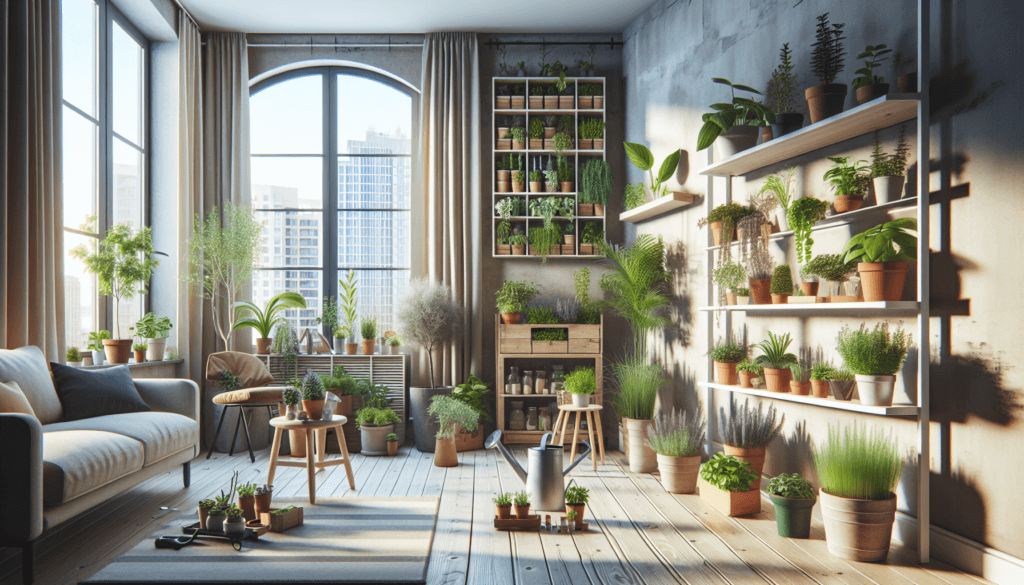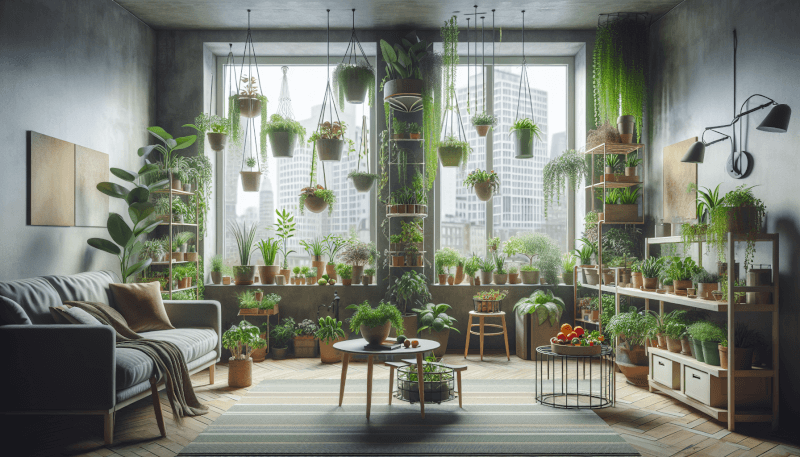Are you an urban dweller with a green thumb? Do you dream of having your own little oasis in the midst of the concrete jungle? Look no further! This article is here to offer you some tips and tricks for indoor gardening specifically tailored for urban apartment dwellers like yourself. Whether you have a spacious loft or a cozy studio, we’ve got ideas to help you bring nature indoors and create your own botanical paradise. From choosing the right plants to maximizing limited space, read on to discover how you can become the proud owner of a thriving indoor garden.

Choosing the Right Plants for Indoor Gardening
Indoor gardening is a great way to bring nature into your urban apartment, but selecting the right plants is essential for a successful and thriving indoor garden. When choosing plants for indoor gardening, there are several factors to consider.
Considering light requirements
Different plants have varying light requirements, so it’s important to assess the amount of natural light your apartment receives. If your apartment gets limited sunlight, choose plants that thrive in low-light conditions, such as pothos, snake plant, or ZZ plant. For apartments with ample natural light, consider plants like succulents, peace lilies, or rubber trees that prefer brighter conditions.
Assessing space availability
Space is often limited in urban apartments, so it’s critical to consider the size of the plants you choose. For small apartments with limited floor space, opt for compact plants like mini succulents or bonsai trees that can be placed on windowsills or shelves. If you have more space, larger plants like fiddle leaf figs or monstera deliciosas can be statement pieces in your living area.
Taking care of temperature needs
Indoor plants have varying temperature preferences, so consider the temperature range of your apartment before making your selections. Tropical plants, such as orchids or ferns, thrive in warm and humid conditions. In contrast, desert plants like cacti or succulents prefer drier and warmer environments. Understanding your apartment’s temperature patterns will help you select the right plants for your indoor garden.
Understanding water and humidity requirements
Water and humidity levels are crucial for indoor plant health. Some plants, like ferns or peace lilies, thrive in consistently moist soil, while others, like succulents, prefer drier conditions. Assessing your ability to maintain proper watering schedules and humidity levels will help you choose plants that can thrive in your apartment’s environment.
Creating an Indoor Garden Space
Once you’ve selected the right plants for your indoor garden, creating a suitable space for them is the next step. Maximizing the available space in your apartment and arranging plants strategically can transform any corner into a lush and vibrant indoor garden.
Evaluating available space
Take a close look at your apartment and identify areas that can be utilized for indoor gardening. Windowsills, shelves, and even unused corners can be transformed into green havens. Consider utilizing vertical space by hanging plants from the ceiling or wall-mounted planters.
Choosing containers and pots
Selecting the right containers and pots is not only essential for the aesthetics of your indoor garden but also for the health of your plants. Make sure your pots have proper drainage to prevent overwatering and root rot. Ceramic or plastic pots are popular choices as they retain moisture well and provide insulation for the roots.
Optimizing vertical space with hanging plants
If you’re short on floor space, hanging plants can be a fantastic option. Utilize macrame hangers, hooks, or wall-mounted planters to suspend your plants from the ceiling or walls. Hanging plants not only save space but also create a visually appealing display.
Arranging plants based on light needs
When arranging your indoor garden, consider the specific light requirements of each plant. Group plants with similar light needs together to ensure they receive the appropriate amount of sunlight. This will help prevent plants from getting overshadowed or deprived of light in a crowded space.

Providing Adequate Lighting
Indoor plants heavily rely on lighting, and it’s crucial to provide them with enough light for optimal growth. Understanding natural light sources, supplementing with artificial lighting, and knowing different types of grow lights are essential aspects of indoor gardening.
Identifying natural light sources
Take note of the natural light sources in your apartment. South-facing windows typically provide the brightest light, while north-facing windows usually offer softer, indirect light. East and west-facing windows fall somewhere in between. Understanding your apartment’s natural light patterns will help you place your plants in the best spots to thrive.
Supplementing with artificial lighting
If your apartment lacks sufficient natural light, consider supplementing it with artificial lighting. LED grow lights are energy-efficient and emit the full spectrum of light required for photosynthesis. Position the lights to mimic the natural daylight cycle, ensuring your plants receive the necessary light for their growth.
Understanding different types of grow lights
There are various types of grow lights available on the market, each with its own set of benefits. Fluorescent lights, such as T5 or T8 bulbs, are affordable and suitable for most indoor plants. High-intensity discharge (HID) lights, like metal halide (MH) or high-pressure sodium (HPS), provide intense light and are ideal for plants in the flowering stage. Research different types of grow lights to choose the best option for your plants’ specific needs.
Calculating lighting duration
Plants require a sufficient duration of light exposure to thrive. Most indoor plants need at least 12-16 hours of light per day. Consider investing in a programmable timer to ensure consistent lighting duration for your plants. By maintaining the appropriate lighting schedule, your indoor garden will receive the steady supply of light necessary for healthy growth.
Watering and Humidity Control
Watering indoor plants and maintaining adequate humidity levels are key factors in their overall well-being. Understanding the frequency of watering, appropriate watering techniques, and humidity control methods will help ensure your plants stay healthy and happy.
Determining watering frequency
Different plants have different watering needs, so it’s important to determine the appropriate watering frequency for each species. Overwatering can lead to root rot, while underwatering can cause dehydration. Research the specific watering requirements of your plants and develop a watering schedule accordingly.
Choosing appropriate watering techniques
When watering indoor plants, it’s important to use the appropriate techniques to prevent waterlogging or damage to foliage. It’s generally recommended to water plants until excess water drains out from the bottom of the pot. Avoid splashing water on the leaves to minimize the risk of disease. Consider using a watering can or a narrow-spouted jug for precise and controlled watering.
Monitoring humidity levels
Indoor environments can often be dry, especially during winter when the heating is on. Plants that prefer high humidity, like ferns or orchids, might struggle in such conditions. Use a hygrometer to monitor humidity levels in your apartment and adjust accordingly. Misting your plants with water or placing a humidifier nearby can also help increase humidity levels.
Using pebble trays and humidifiers
To further elevate humidity levels for humidity-loving plants, consider using pebble trays or humidifiers. Fill a tray with water and place pebbles or stones on top, then position your plant on the pebbles. As the water evaporates, it creates a moist microclimate around the plant, increasing humidity. Humidifiers are also an effective way to maintain optimal humidity levels in your indoor garden.

Soil and Fertilization
Providing your indoor plants with suitable soil and proper fertilization is vital for their growth and overall health. Selecting the right potting soil, considering soil amendments, and understanding organic and synthetic fertilizers will help you keep your plants well-nourished.
Selecting suitable potting soil
Choosing the right potting soil is essential for indoor gardening success. Look for a well-draining soil mix specifically formulated for houseplants. Avoid using garden soil or heavy clay-based soils, as they can prevent proper drainage and lead to root rot. Potting mixes with added perlite or vermiculite ensure good drainage and aeration, promoting healthy root growth.
Considering soil amendments
Soil amendments can improve the texture and nutrient content of your potting soil. Organic matter, such as compost or well-rotted manure, can be added to enrich the soil and provide essential nutrients. Vermiculite or coco coir can also enhance water-holding capacity and improve aeration. Consider incorporating soil amendments to optimize the growing conditions for your indoor plants.
Choosing organic or synthetic fertilizers
Indoor plants benefit from regular fertilization as they don’t have access to natural nutrient sources like outdoor plants. You can choose between organic and synthetic fertilizers. Organic fertilizers, such as compost tea or fish emulsion, release nutrients gradually and improve soil health. Synthetic fertilizers, on the other hand, provide immediate nutrients. Either option can keep your plants nourished, but be sure to follow the recommended application rates to avoid overfertilization.
Understanding fertilization schedules
Establishing a fertilization schedule is crucial for the well-being of your indoor plants. Most houseplants benefit from regular fertilization every 4-6 weeks during the growing season (spring and summer) and reduced or no fertilization during the dormant season (fall and winter). Always read the instructions on the fertilizer packaging and adjust the schedule according to the specific needs of your plants.
Maintaining Temperature and Ventilation
Maintaining an appropriate temperature range and ensuring proper ventilation are crucial for indoor plant health. Understanding temperature preferences, avoiding drafts and fluctuations, ensuring adequate air circulation, and considering heating or air conditioning are vital aspects of indoor gardening.
Providing proper temperature range
Different plants have different temperature preferences, so it’s important to consider the specific needs of your plants. Most common houseplants prefer temperatures between 60-75°F (15-24°C). However, some tropical plants may require higher temperatures, while cold-hardy plants might tolerate lower temperatures. Understanding your plants’ temperature tolerance will help you provide the optimal conditions for their growth.
Avoiding drafts and temperature fluctuations
Drafts and sudden temperature changes can stress indoor plants and disrupt their growth. Avoid placing plants near drafty windows, doors, or heating vents. Be mindful of temperature fluctuations caused by air conditioning or heating systems. Maintaining a consistent temperature within the preferred range for your plants will promote healthy growth and prevent unnecessary stress.
Ensuring adequate air circulation
Proper air circulation is essential for indoor plants as it helps prevent the buildup of stagnant air and potential issues like mold or pests. Position your plants away from walls or tightly-packed spaces to allow air to circulate freely around them. Opening windows or using fans can promote air circulation and create a healthier environment for your indoor garden.
Consideration for air conditioning and heating
Keep in mind that air conditioning and heating can affect the temperature and humidity levels of your indoor garden. Air conditioning can cause dry air, while heating can dry out the air as well. Adjusting humidity levels with humidifiers or misting can counteract the drying effects of air conditioning and heating systems, ensuring optimal conditions for your plants.

Pruning and Maintenance
Regular pruning and maintenance are essential for keeping your indoor garden looking its best and promoting healthy plant growth. Understanding pruning techniques, removing dead leaves and flowers, promoting bushier growth, and identifying and treating common plant diseases are important aspects of plant care.
Understanding pruning techniques
Pruning is the process of removing specific parts of a plant to shape it, remove dead or diseased portions, or promote growth. Each plant species may require different pruning techniques, so it’s essential to familiarize yourself with proper pruning methods. Generally, you can remove yellow or brown leaves, trim leggy stems, or pinch back the tips of plants to encourage fuller growth.
Removing dead leaves and flowers
Regularly removing dead leaves and flowers not only improves the appearance of your indoor garden but also helps prevent the spread of disease and pests. Dead leaves and spent flowers can become breeding grounds for harmful fungi and insects. Gently pluck or trim away any dead or withered parts to maintain the overall health and beauty of your plants.
Promoting bushier growth
To encourage bushier growth, you can use pruning techniques such as pinching back or trimming. Pinching back involves removing the tip of a stem between your thumb and forefinger. This technique stimulates branching and results in a fuller, more compact plant. Regular pruning and pinching can keep your indoor plants well-shaped and lush.
Identifying and treating common plant diseases
Indoor plants are not immune to diseases, and it’s important to be vigilant for signs of common plant ailments. Keep an eye out for symptoms like discolored or spotted leaves, wilting, or the presence of pests. If you notice any issues, identify the problem and take appropriate measures to treat or prevent the spread of the disease. Organic treatments, such as neem oil or beneficial insects, can help control pests, while fungicides can combat fungal infections.
Pest Control in Indoor Gardens
Despite being indoors, your indoor garden is not entirely safe from pests. Identifying common indoor plant pests, preventing infestations, using natural control methods, and resorting to insecticidal soaps or neem oil when necessary can help you keep your plants pest-free.
Identifying common indoor plant pests
Several pests can infest indoor plants, including aphids, mealybugs, spider mites, and fungus gnats. Familiarize yourself with the appearance and behavior of these common pests so that you can take prompt action if an infestation occurs. Regularly inspecting your plants for signs of pests will help you catch and address the problem early.
Preventing pest infestations
Prevention is key when it comes to pests. Inspect any new plants before bringing them into your indoor garden to ensure they are free of pests. Quarantine new plants for a few weeks to monitor for any signs of infestation. Keep your indoor garden clean by removing fallen leaves and debris promptly, as they can attract pests. Avoid overwatering and overfertilizing, as excessive moisture and nutrient-rich soil can create a favorable environment for pests.
Natural pest control methods
Many natural methods can deter and control pests in your indoor garden. Introduce beneficial insects like ladybugs or parasitic wasps, which feed on common plant pests. Neem oil, derived from the neem tree, is a natural insecticide that can effectively control pests. Other natural remedies include insecticidal soaps or homemade sprays made from ingredients like garlic or chili peppers. Regularly inspect and treat your plants with natural pest control methods to keep them healthy and pest-free.
Using insecticidal soaps and neem oil
Insecticidal soaps and neem oil are effective options for controlling persistent pests. These products are safe for most indoor plants when used according to the instructions. Insecticidal soaps work by suffocating soft-bodied insects like aphids or mealybugs, while neem oil disrupts the feeding and reproductive abilities of a wide range of pests. Use these treatments sparingly and as a last resort, as excessive use can harm beneficial insects and your plants.

Propagation and Repotting
Indoor gardening also offers the opportunity to propagate plants and repot them when necessary. Exploring propagation methods, using stem cutting and division, creating suitable conditions for propagation, and repotting plants appropriately will allow you to expand your indoor garden and promote healthy growth.
Exploring propagation methods
Propagation is the process of creating new plants from existing ones. There are several propagation methods you can try, including stem cutting, leaf cuttings, or division. Stem cutting is a popular method where you cut a stem with several leaf nodes and root it in water or a suitable growing medium.
Using stem cutting and division
Stem cutting involves selecting a healthy stem, cutting it below a leaf node, and placing the cutting in water or a rooting hormone to promote root development. Leaf cuttings can be taken from plants with fleshy leaves, such as succulents. Division is suitable for plants that have clumps or offsets, like snake plants or spider plants.
Creating suitable conditions for propagation
Propagation requires specific environmental conditions to ensure successful rooting and growth. Providing the right amount of moisture, warmth, and light are vital for encouraging root development. Place your cuttings or divided plants in a warm area with bright, indirect light. Mist the cuttings occasionally to maintain humidity and prevent them from drying out.
Repotting plants when needed
As your indoor plants grow, they may outgrow their containers or require fresh soil. When it’s time to repot, select a slightly larger pot and use fresh potting soil. Gently remove the plant from its current pot, loosen the roots, and place it in the new pot. Fill in the gaps with fresh soil and lightly tamp it down. Regular repotting will ensure your plants have enough space for their roots to grow and access fresh nutrients.
Harvesting and Using Homegrown Produce
One of the joys of indoor gardening is the ability to grow your own herbs and vegetables. Knowing when to harvest, properly storing harvested produce, using homegrown herbs and vegetables in cooking, and preserving excess produce will allow you to savor the fruits of your labor.
Knowing when to harvest
Different plants have different harvest times, so it’s important to know when to pick your produce for optimal flavor and freshness. Leafy greens like lettuce or spinach can be harvested when the leaves are mature but before they turn bitter. Herbs should be picked just before they flower for the best flavor. Larger vegetables like peppers or tomatoes should be harvested when they are fully ripe.
Properly storing harvested produce
After harvesting, it’s important to store your produce properly to maintain its quality. Leafy greens can be stored in sealed plastic bags or containers in the refrigerator to prevent wilting. Herbs can be wrapped in a damp paper towel and stored in a plastic bag to prolong freshness. Larger vegetables should be stored in a cool, dry place away from direct sunlight.
Using homegrown herbs and vegetables in cooking
One of the advantages of indoor gardening is having fresh herbs and vegetables at your fingertips for cooking. Incorporate your homegrown produce into your favorite recipes to enhance the flavor and experience. Fresh basil in pasta sauce, homegrown tomatoes in salads, or homegrown mint in homemade mojitos are just a few examples of how you can enjoy the taste of your indoor garden in your everyday meals.
Preserving excess produce
Sometimes, your indoor garden might produce more herbs or vegetables than you can consume immediately. In such cases, consider preserving the excess produce to enjoy later. Herbs can be dried by hanging them in bunches or dehydrating them. Vegetables can be blanched and frozen or used to make jams, pickles, or sauces. Preserving your excess harvest allows you to enjoy the flavors of your indoor garden even during the off-season.
By following these tips and guidelines, you can create a thriving indoor garden in your urban apartment. From selecting the right plants to maintaining proper lighting, temperature, and humidity, indoor gardening allows you to bring the beauty and joy of nature into your living space. Whether you grow herbs for cooking or create a lush oasis of green, your indoor garden will provide you with a connection to nature and a sense of tranquility in your urban dwelling. Happy gardening!

